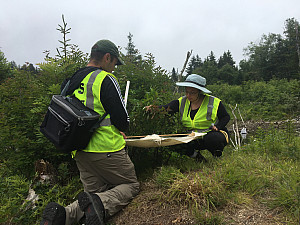Will poop DNA reveal the missing link to the trophic transfer of mercury? By Batya Johnson
July 08, 2018
Open gallery

Matt Garafalo and Batya Johnson collecting insects in Acadia National Park
*Batya is doing summer research in Acadia National Park with Dr. Jackson as part of the Acadia Bug Project (www.acadiabugproject.com). You can follow the team on social media @JacksonEcoLab on facebook, twitter and instagram*
I wanted to make the most of my time here with my short stay in Maine. I jumped right in the routine of field work and got to assist in the collection of terrestrial and aquatic bugs at our four main sites. Being in the field has helped me actualize my project, but it also has brought up so many more questions and opportunities for investigation into how mercury is transmitted through riparian ecosystems. We know that songbirds in the same habitat can have drastically different levels of mercury, but how does that happen? Is a specific insect responsible for transmitting mercury to songbirds? I will be using DNA metabarcoding to identify the species that the songbirds are eating to hopefully answer some of these questions.
The dirty parts of this project don’t end with inhaling bugs. We have been collecting blood samples from songbirds to test for mercury, but we have also been collecting songbird fecal samples. In the next year, we will be processing these fecal samples using a method called DNA metabarcoding. The metabarcoding process is similar to using the music app shazam. We start with a small sound clip, or in this case several small fragments of DNA that we have recovered from each fecal sample. These DNA sequences are referenced to multiple DNA databases, and just as the app can identify the song from the clip, we can identify the species of bugs that the songbirds are eating. The ability to identify what the songbirds are eating can give us invaluable insight into the songbirds mercury exposure, and will hopefully tell us how mercury is traveling through the riparian ecosystem.
In just over a week, I have learned so much including how to identify local bugs and birds. It has been great to work with familiar faces and exciting to see so many citizen scientists that are getting involved with the project as well. I have had so much fun learning, participating in fieldwork, and exploring Acadia National Park. One week felt like a day, and I have never seen a beautiful place.